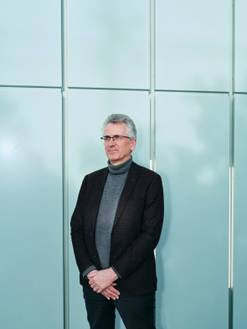Working together
Saint-Gobain might trade in sustainable construction solutions but people are at the heart of every decision that the company makes – whether that’s encouraging the 160,000 employees tasked with driving innovation or fulfilling the needs of the countless customers around the globe.

From the prototype-led Fab Labs workshops to The Hackathon’s intensive creative-thinking summit, Saint-Gobain regularly sets up events and situations that are conducive to creativity.
With an innovation strategy that centres on conserving natural resources and transitioning to zero-carbon systems while prioritising customer wellbeing and life quality, Saint-Gobain has a clear mission. The tone is set by CEO Benoit Bazin and his leadership team. Over the next four pages, key members share insight into how they are establishing an inclusive, responsible and motivational workplace that is better for all.

1.
Claire Pedini
Senior vice-president, Human Resources and Corporate Social Responsibility, Saint-Gobain
Pedini joined the leadership team at Saint-Gobain in 2010. She has been instrumental in developing a TEC (Trust Empowerment Collaboration) culture and she describes her role as “change management”: evolving with the company as it puts sustainability at the core of its strategy.
Q: What first drew you to working at Saint-Gobain?
A: What was very attractive was the change and the journey that the chairman and CEO wanted to embark on. I saw the willingness to really change the way that Saint-Gobain was working, to diversify the workforce and open more to the outside.
Q: What does that involve?
A: Progressively changing from a “push” model – selling our high-quality product to the customers – to a “pull” model – starting from the needs of the customers and markets.
Q: How is Saint-Gobain reducing its carbon footprint?
A: The solutions that we sell decrease the carbon emissions of the value chain. We also want to minimise our own footprint by decreasing our emissions and energy use.
Q: What actions have you taken to improve diversity of hires?
A: We always start with awareness then include diversity and inclusion in all HR policies and measure all progress. Diversity is an asset; it brings wealth, different points of view and value to the customers who are themselves diverse.
Q: What are your sustainable development targets?
A: We have three. The first is to contribute to a decarbonised home. The second is to provide more performance to the customers with less. And the third is “better living for all” – our ability to sell affordable solutions so that many people, starting with our employees, can have access to a better quality of life.

2.
Pascal Eveillard
Director, Sustainable Construction and Sustainable Business Development, Saint-Gobain
With Saint-Gobain for 24 years, Eveillard now leads a department that helps businesses to define strategies, develop best practices and innovate in the sustainable construction realm. His team also aids market transformation by supporting voluntary schemes and advocating for policy change.
Q: How has the sustainable construction market transformed in recent years?
A: I like to say sustainability is not a straight line, it’s a journey with ups and downs. Demand is accelerating everywhere in the world but it’s moving faster in Europe.
Q: Do you factor in global developments or just fulfil local market demands?
A: Construction is very local. We need to answer local needs and expectations. In parallel, we target projects seeking certification: this is a good way to introduce more advanced sustainable innovations to customers motivated to build better.
Q: How do you find proactive solutions for people?
A: For buildings seeking higher certification levels, we map the requirements of those certifications and match them with our solutions. Early in the design stage, we will interact with developers, architects and engineers to best understand their ambitions and proactively propose our most sustainable options. It is a win-win approach.
Q: How are you engaging tomorrow’s architects?
A: We have run an Architecture Student Contest since 2004. It serves as a unique platform for aspiring architects to delve into sustainable construction. With more than 1,300 participants from 30 countries, the contest has become a global stage where creativity, sustainability and innovation converge to shape the future of architecture.


